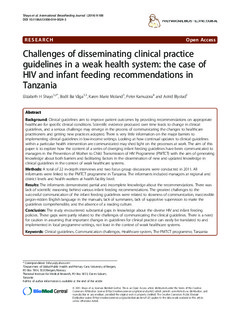| dc.contributor.author | Shayo, Elizabeth H. | |
| dc.contributor.author | Våga, Bodil Bø | |
| dc.contributor.author | Moland, Karen Marie | |
| dc.contributor.author | Kamuzora, Peter | |
| dc.contributor.author | Blystad, Astrid | |
| dc.coverage.spatial | Tanzania | nb_NO |
| dc.date.accessioned | 2017-01-19T14:46:57Z | |
| dc.date.available | 2017-01-19T14:46:57Z | |
| dc.date.issued | 2014-12 | |
| dc.identifier.citation | Shayo, E.H. et al. (2014) Challenges of disseminating clinical practice guidelines in a weak health system: the case of HIV and infant feeding recommendations in Tanzania. International Breastfeeding Journal, 9(188) | nb_NO |
| dc.identifier.uri | http://hdl.handle.net/11250/2427887 | |
| dc.description.abstract | Background
Clinical guidelines aim to improve patient outcomes by providing recommendations on appropriate healthcare for specific clinical conditions. Scientific evidence produced over time leads to change in clinical guidelines, and a serious challenge may emerge in the process of communicating the changes to healthcare practitioners and getting new practices adopted. There is very little information on the major barriers to implementing clinical guidelines in low-income settings. Looking at how continual updates to clinical guidelines within a particular health intervention are communicated may shed light on the processes at work. The aim of this paper is to explore how the content of a series of diverging infant feeding guidelines have been communicated to managers in the Prevention of Mother to Child Transmission of HIV Programme (PMTCT) with the aim of generating knowledge about both barriers and facilitating factors in the dissemination of new and updated knowledge in clinical guidelines in the context of weak healthcare systems.
Methods
A total of 22 in-depth interviews and two focus group discussions were conducted in 2011. All informants were linked to the PMTCT programme in Tanzania. The informants included managers at regional and district levels and health workers at health facility level.
Results
The informants demonstrated partial and incomplete knowledge about the recommendations. There was lack of scientific reasoning behind various infant feeding recommendations. The greatest challenges to the successful communication of the infant feeding guidelines were related to slowness of communication, inaccessible jargon-ridden English language in the manuals, lack of summaries, lack of supportive supervision to make the guidelines comprehensible, and the absence of a reading culture.
Conclusion
The study encountered substantial gaps in knowledge about the diverse HIV and infant feeding policies. These gaps were partly related to the challenges of communicating the clinical guidelines. There is a need for caution in assuming that important changes in guidelines for clinical practice can easily be translated to and implemented in local programme settings, not least in the context of weak healthcare systems. | nb_NO |
| dc.language.iso | eng | nb_NO |
| dc.publisher | BioMed Central | nb_NO |
| dc.rights | Navngivelse 4.0 Internasjonal | * |
| dc.rights.uri | http://creativecommons.org/licenses/by/4.0/deed.no | * |
| dc.subject | clinical guidelines | nb_NO |
| dc.subject | communication challenges | nb_NO |
| dc.subject | healthcare system | nb_NO |
| dc.subject | helsevesenet | nb_NO |
| dc.subject | the PMTCT programme | nb_NO |
| dc.subject | HIV | nb_NO |
| dc.subject | amming | nb_NO |
| dc.title | Challenges of disseminating clinical practice guidelines in a weak health system: the case of HIV and infant feeding recommendations in Tanzania | nb_NO |
| dc.type | Journal article | nb_NO |
| dc.type | Peer reviewed | nb_NO |
| dc.rights.holder | © Shayo et al.; licensee BioMed Central. 2015 | nb_NO |
| dc.subject.nsi | VDP::Medisinske Fag: 700::Klinisk medisinske fag: 750::Gynekologi og obstetrikk: 756 | nb_NO |
| dc.source.volume | 9 | nb_NO |
| dc.source.journal | International Breastfeeding Journal | nb_NO |
| dc.source.issue | 188 | nb_NO |
| dc.identifier.doi | 10.1186/s13006-014-0024-3 | |

